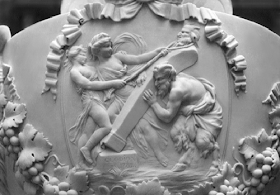Other Interesting Pages
▼
Friday, August 27, 2010
Finials and Urns
I have a thing for finials and urns, and sometimes I hit the jackpot and find both in the same object. I found this wooden finial recently at a St. Petersburg antique shop. The carved flame and wreath base made it a must-have. Incidentally, the correct description of the grooves, as they would apply to columns, is "serpentine fluting."
The base has one corner that needs to be repaired. It looks as though there might have been a struggle to pry it from its last home, but how fortunate that there was no further damage.
How is it that some of us are so drawn to certain iconic shapes and objects? Is it due to genes, past lives at Versailles, teachers, our environment? I have no doubt that part of my attraction for things classical is because – when I was just out of toddlerhood – I spent many hours following my grandfather as he methodically documented Washington, D. C.'s National Gallery. He used a Zeiss Ikon, always shot in black and white, and always printed on a heavy matte paper. Like the one above, his images were rich in contrast and all these years later, still wonderful to study. This is a detail of an ornamental urn by the French sculptor Claude Michel, known as Clodion. It was carved in 1785.




Thanks for stopping by on my blog. Have enjoyed reading yours.
ReplyDeleteI think the urn is beautiful, and you are lucky I wasn't there before you! The serpentine fluting is exquisite, as is the laurel and ribbon wreath at the base. I love to learn such terms.
ReplyDeleteHow will you have it restored? Perhaps the chip cut out square and and new square piece put in with dowels or pegs in the traditional way.... I am also drawn to particular forms...obelisks, URNS!, neoclassical candlesticks, and faux bamboo furniture in the garden. Don't you think these things are more beautiful when they have similar objects in their midst? I'll bet your finial is more attractive because it has similar pieces in your collection.
Of course a celebrity decorator like Tarlow would have these copied and sold for big bucks, and you would soon see pairs of them sprouting in the homes of those who hire others to do it for them.
Thank you so much for your comments. Repairing the urn would make a great follow-up posting, wouldn't it? The urn also appears to have been hurriedly painted with a putty color for quick sale. I'll probably repaint it the same color after the repair, but I'll leave the bottom unpainted to show that the urn is indeed carved wood.
ReplyDeletePutty sounds like a suitable colour. If you leave the entire base block unpainted, it might look too abrupt. I have similar pieces and I would suggest painting it such that the corners appear paint-chipped or slightly distressed, revealing the wood below. I have a beautiful old Corinthian capital that I use as a small table, and acanthus wall brackets that I've done this way, and I love the effect.
ReplyDeleteYou get the light effect of pale paint, but the corners reveal that they are old wood rather than resin copies made last year in China.
Your pieces sound beautiful, and I know that at some point, I'll be doing a post on capitals.
ReplyDeleteI should clarify that when I said that I'd leave the bottom unpainted, I was speaking of that plane which is unseen. That way, if someone picked the urn up and turned it over, they'd know the material was wood, and not some resin!
That's urn finial's a knockout, Mark, and if I had been in that shop at the same time as you & Square with Flair, they might have had to call in the cops to settle the matter. I know gentlemen are supposed to be able to resolve things amicably, but you know how it is. Anyway, the spiral fluting is beautiful & the incised line along the face of the urn between the flutes--I know there's a name for that face, but I don't feel like looking it up at the moment--makes it even more elegant. In fact, that same elegant detail shows up on my absolute favorite item at the Metropolitan Museum in NYC, a Roman marble urn from the 2nd century which stopped me dead in my tracks the first time I saw it after the Museum re-installed the Classical galleries in the old Dorotheum.
ReplyDeletehttp://www.metmuseum.org/toah/works-of-art/2007.31a,b
Which, I guess, is appropriate, since that piece may actually be a funerary urn. I only hope that when it's time for me to shuffle off this mortal coil, the bereaved send me off in such grand style. At any rate, you snagged quite the prize.
Hello, Simply Grand - I saw the strigilated urn you mention on my own recent trip to the Metropolitan, and was very taken with it, too. I enjoyed that the serpentine fluting was mirrored by the serpent handles. Striking! (No pun intended.)
ReplyDelete